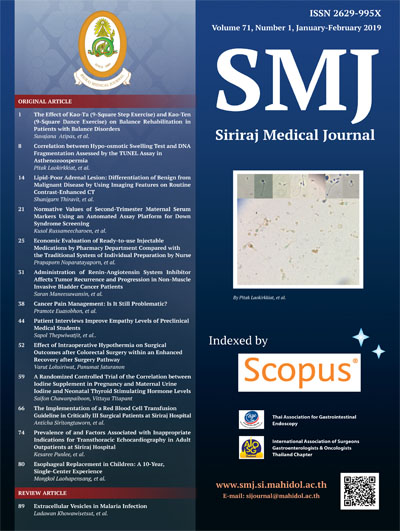Correlation between the Hypoosmotic SwellingT and DNA Fragmentation Assessed by the TUNEL Assay in Asthenozoospermia
DOI:
https://doi.org/10.33192/Smj.2019.02Keywords:
Hypoosmotic swelling test; TUNEL; asthenozoospermia; male infertility; intracytoplasmic sperm injectionAbstract
Objective: To study the correlation between the hypoosmotic swelling test (HOST) and DNA fragmentation in
asthenozoospermia assessed by the terminal deoxynucleotidyl transferase‐mediated deoxyuridine triphosphatebiotin
nick end‐labeling (TUNEL) assay.
Methods: This cross-sectional study was conducted in 27 semen samples obtained from infertile men with
asthenozoospermia. Both HOST and TUNEL assay were performed for each sample. The sperm swelling pattern
and positive apoptosis staining of individual spermatozoa were evaluated. HOST and TUNEL scores, and the
proportion of positive staining in each grade were calculated in each sample.
Results: The results showed a negative correlation between HOST and TUNEL scores (r = -0.428, P = 0.026). Sperm
swelling grade A had a higher incidence of positive apoptosis staining when compared with other grades (P < 0.01).
There was no statistically significant difference in positive apoptotic staining between other grades; nevertheless,
sperm swelling grade D tended to have a lower incidence of positive apoptosis staining.
Conclusion: Based on the results of this study, HOST may be used as an optional test to identify DNA-intact
spermatozoa whereby sperm with a grade D swelling pattern should be selected preferentially for intracytoplasmic
sperm injection (ICSI), whereas sperm with a grade A swelling pattern should be avoided for ICSI.
Downloads
Published
How to Cite
Issue
Section
License
Authors who publish with this journal agree to the following conditions:
Copyright Transfer
In submitting a manuscript, the authors acknowledge that the work will become the copyrighted property of Siriraj Medical Journal upon publication.
License
Articles are licensed under a Creative Commons Attribution-NonCommercial-NoDerivatives 4.0 International License (CC BY-NC-ND 4.0). This license allows for the sharing of the work for non-commercial purposes with proper attribution to the authors and the journal. However, it does not permit modifications or the creation of derivative works.
Sharing and Access
Authors are encouraged to share their article on their personal or institutional websites and through other non-commercial platforms. Doing so can increase readership and citations.














